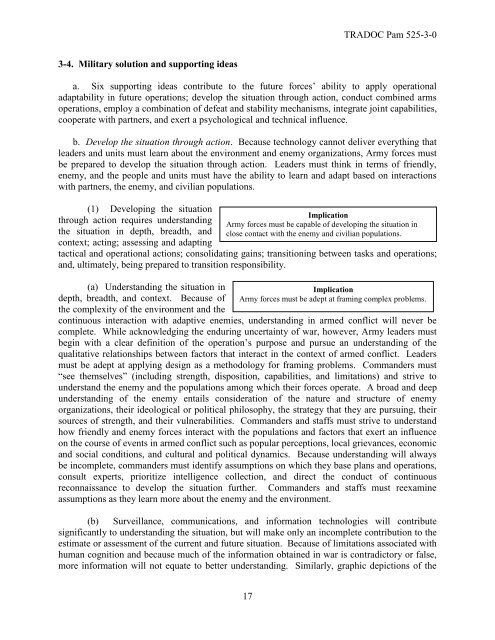(Pam) 525-3-0, The Army Capstone Concept - Federation of ...
(Pam) 525-3-0, The Army Capstone Concept - Federation of ...
(Pam) 525-3-0, The Army Capstone Concept - Federation of ...
You also want an ePaper? Increase the reach of your titles
YUMPU automatically turns print PDFs into web optimized ePapers that Google loves.
3-4. Military solution and supporting ideas<br />
17<br />
TRADOC <strong>Pam</strong> <strong>525</strong>-3-0<br />
a. Six supporting ideas contribute to the future forces’ ability to apply operational<br />
adaptability in future operations; develop the situation through action, conduct combined arms<br />
operations, employ a combination <strong>of</strong> defeat and stability mechanisms, integrate joint capabilities,<br />
cooperate with partners, and exert a psychological and technical influence.<br />
b. Develop the situation through action. Because technology cannot deliver everything that<br />
leaders and units must learn about the environment and enemy organizations, <strong>Army</strong> forces must<br />
be prepared to develop the situation through action. Leaders must think in terms <strong>of</strong> friendly,<br />
enemy, and the people and units must have the ability to learn and adapt based on interactions<br />
with partners, the enemy, and civilian populations.<br />
(1) Developing the situation<br />
through action requires understanding<br />
the situation in depth, breadth, and<br />
context; acting; assessing and adapting<br />
Implication<br />
<strong>Army</strong> forces must be capable <strong>of</strong> developing the situation in<br />
close contact with the enemy and civilian populations.<br />
tactical and operational actions; consolidating gains; transitioning between tasks and operations;<br />
and, ultimately, being prepared to transition responsibility.<br />
(a) Understanding the situation in<br />
depth, breadth, and context. Because <strong>of</strong><br />
the complexity <strong>of</strong> the environment and the<br />
Implication<br />
<strong>Army</strong> forces must be adept at framing complex problems.<br />
continuous interaction with adaptive enemies, understanding in armed conflict will never be<br />
complete. While acknowledging the enduring uncertainty <strong>of</strong> war, however, <strong>Army</strong> leaders must<br />
begin with a clear definition <strong>of</strong> the operation’s purpose and pursue an understanding <strong>of</strong> the<br />
qualitative relationships between factors that interact in the context <strong>of</strong> armed conflict. Leaders<br />
must be adept at applying design as a methodology for framing problems. Commanders must<br />
―see themselves‖ (including strength, disposition, capabilities, and limitations) and strive to<br />
understand the enemy and the populations among which their forces operate. A broad and deep<br />
understanding <strong>of</strong> the enemy entails consideration <strong>of</strong> the nature and structure <strong>of</strong> enemy<br />
organizations, their ideological or political philosophy, the strategy that they are pursuing, their<br />
sources <strong>of</strong> strength, and their vulnerabilities. Commanders and staffs must strive to understand<br />
how friendly and enemy forces interact with the populations and factors that exert an influence<br />
on the course <strong>of</strong> events in armed conflict such as popular perceptions, local grievances, economic<br />
and social conditions, and cultural and political dynamics. Because understanding will always<br />
be incomplete, commanders must identify assumptions on which they base plans and operations,<br />
consult experts, prioritize intelligence collection, and direct the conduct <strong>of</strong> continuous<br />
reconnaissance to develop the situation further. Commanders and staffs must reexamine<br />
assumptions as they learn more about the enemy and the environment.<br />
(b) Surveillance, communications, and information technologies will contribute<br />
significantly to understanding the situation, but will make only an incomplete contribution to the<br />
estimate or assessment <strong>of</strong> the current and future situation. Because <strong>of</strong> limitations associated with<br />
human cognition and because much <strong>of</strong> the information obtained in war is contradictory or false,<br />
more information will not equate to better understanding. Similarly, graphic depictions <strong>of</strong> the
















